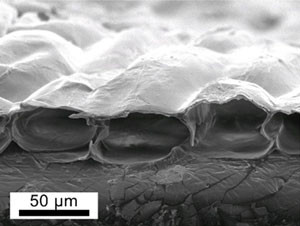In recent years the field of artificial muscle technology has been rapidly expanding and advancing. This week researchers at the National Taiwan University have revealed a method of producing tiny muscles from onion cells.
The team were originally aiming to create an artificial structure which would contract when triggered, according to the lead researcher Weh-Pin Shih. They were using “micro machinery to fabricate polymer muscles”, said Shih, when it was observed that onion cells had both a similar structure and dimensions.
It was then decided to extract onion epidermal cells and coat each side in gold, which acts as an electrode as it can readily conduct electricity. Additionally, the gold has an essential role in the ability to bend in different directions, depending on the voltage applied.
The coatings of gold added to each side were intentionally of different thickness so that the cell stiffness would become asymmetric from top to bottom. As a result of this asymmetry, when high voltage was applied to the cells they contracted and flexed upwards while when low voltage was applied the opposite effect was observed. This ability makes these cells different to previous artificial muscles: Shih commented that they “contract and bend like human muscles.”
So far the team have used these tiny muscles to construct simple tools such as a pair of tweezers to grip and move a cotton wool ball. Andrew Conn, from the University of Bristol, believes the study will have a major impact in the field.
“‘[What will] get their attention is the fact that they’re using a readily available, natural material and it doesn’t require huge amounts of processing to get a functional actuator.”
